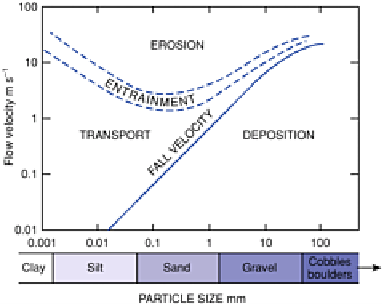Environmental Engineering Reference
In-Depth Information
alters the mean size and particle distribution of the sediment body. In this way,
mean
particle size may actually increase as fines are removed. Particle mass closely
corresponds to the velocity
Figure 12.11
Flow velocity thresholds for the entrainment,
transport and deposition of granular particles, using BSI
particle size classification.
Source: After Hjulström (1935).
and viscosity of the transporting medium. Figure 12.11 shows particle size/velocity
relationships associated with the entrainment, transport and deposition of single spherical
grains in water.
Water and wind produce well sorted sediments, i.e. with small standard deviations
about mean particle size, reflecting the energy environment of transport (in-transit
sediment) or deposition (deposited sediment). Low-energy lacustrine, lagoonal or deep-
water sediments are fine-grained, and high-energy torrent or storm beach sediments are
coarse-grained. The higher viscosity of glaciers, debris flows and basal elements of
turbidity current (see below) - with ice or clasts themselves providing buoyancy -
substantially reduces degrees of sorting and particle size distributions may be bi- or
multimodal (Figure 12.12). Textural changes occur in transit and are retained at the point
of deposition, where the sediment compactness is measured by the
packing density
of
grains and the
void ratio
of remaining spaces. This is determined by particle size, shape
and sorting and also reflects syn- or post-depositional
overburden pressure
- exerted by
overlying sediments, water or ice bodies.
Sediments also acquire directional and structural properties. Particles deposited by
anything other than settling through still water or air are subject to an
anisotropic force

